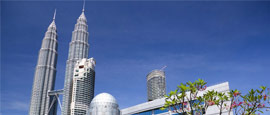Kuala Lumpur History
It’s hard to believe Kuala Lumpur didn’t even exist 200 years ago.
Kuala Lumpur's history is surprisingly short – it only came into existence in the late 1850s, when a group of Chinese tin prospectors settled where the Klang and Gombak rivers meet in what was then deep mosquito-ridden jungle. The mines developed into a trading post which evolved into a frontier town.
Its development into modern day 'KL' began under British colonial rule, when the scruffy little settlement ridden by inter-gang rivalry was placed under the control of a Chinese Kapitan or headman. His name was Yap Ah Loy, and he was responsible for the layout of the city.
The jungle was cleared, and the construction of more substantial brick and stone buildings commenced. The use of skilled Chinese carpenters meant that many of the buildings that sprang up resembled the distinctive shop houses of southern China.
The construction of a railway line, the establishment of laws, courts, a prison and a school all contributed to the city’s early modernisation. This led to KL being proclaimed capital of the newly formed Federated Malay States at the end of the 19th century.
Different communities settled into distinct areas – the Chinese around Chinatown and the commercial district, Malays and Indians along Java Street, and the British around Padang, now known as Merdeka Square.
KL’s growth continued apace until capture by the Japanese in 1942. But British administration returned post-war, and preparations for Malaysian independence began in earnest, coming to fruition in 1963.
In 1969, race riots kicked off between the Malays and the Chinese. Almost 200 people died during the 13 May Incident, leading to nationwide economic reform to reduce Chinese monopolies.
Since independence, KL has steadily grown, particularly during the boom years of the 1980s and 1990s, into the ultra-modern (in parts) city it is today.
Did you know?
• Kuala Lumpur’s name translates as ‘muddy confluence’.
• Kuala Lumpur hosted the 1998 Commonwealth Games.
• At 379m (1,2142ft), the Petronas Twin Towers were the world’s tallest buildings between 1998 and 2004.
Do you have any Feedback about this page?
© 2025 Columbus Travel Media Ltd. All rights reserved. No part of this site may be reproduced without our written permission, click here for information on Columbus Content Solutions.




 You know where
You know where